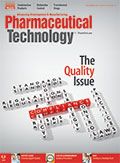Manufacturing Considerations for Transdermal Delivery Systems
Drug and adhesive formulation are crucial to the development of microneedle patches for pharmaceutical transdermal delivery systems.
everythingpossible/stock.adobe.com

Transdermal drug delivery is seen as a desirable alternative to oral delivery, says Hayley Lewis, senior vice-president of Operations at Zosano Pharma, which is a pioneer in microneedle therapeutics. Transdermal drug delivery systems (TDDS) include various constructions of patches to be placed on the skin, microneedles applied using devices, and patches that incorporate microneedles, such as Zosano’s product. Pharmaceutical Technology spoke with Lewis about manufacturing considerations for TDDS and about Zosano’s trademarked Adhesive Dermally Applied Microneedle System, which is currently in clinical trials.
Microneedle TDDS
PharmTech:What are some of the advantages of microneedle TDDS?
Lewis (Zosano): For active/assisted TDDS technologies involving microneedles, achieving immediate release in a less-invasive manner through the intradermal route is the major distinguishing characteristic of the technology. In addition, limitations with respect to the molecular weight of the drug are not of concern with this form of assisted transdermal technology. For therapeutic protein and peptide delivery, while intradermal delivery may provide a more advantageous pharmacokinetic profile compared with subcutaneous or intramuscular injections, other tangible patient benefits, such as easy self-administration, less perceived pain, enhanced safety, and ambient temperature stability, are correspondingly essential to make microneedle-mediated TDDS a compelling product concept.
Zosano Pharma has demonstrated the utility of its Adhesive Dermally Applied Microneedle System (ADAM) platform in multiple clinical trials. For example, M207 is Zosano’s proprietary zolmitriptan-coated microneedle patch designed to rapidly deliver the drug during a migraine attack; it is currently in a Phase III clinical trial.
Manufacturing considerations
PharmTech:What are some of the primary considerations for developing and manufacturing TDDS patches?
Lewis (Zosano):A major impediment to overcome in formulating adhesives for TDDS is the difficulty in maintaining compatibility between the API and the adhesive. Adhesive manufacturers should offer formulations with judiciously designed chemistries that will not react with the API or alter its physical properties. In addition, adhesive manufacturers need to fully characterize their adhesives with respect to residual monomers, initiator byproducts (e.g., tetramethylsucconitirle), and any potential degradants. Biocompatibility of an adhesive with the skin is a major concern in the design of any transdermal patch.
The physicochemical properties of the API need to be determined with respect to molecular weight, partition coefficient, melting point, pKa, solubility, pH effects, particle size, and polymorphism. The likelihood of precipitation, particle growth, change in crystal habit, or other API characteristics that may affect the thermodynamic activity from changes in temperature and storage should be evaluated.
In-vitrodrug release is an important component of drug product characterization and is routinely used as a quality control test in assessing reproducibility of the drug product manufacturing process.
The tackiness of the TDDS also needs to be assessed; typically four tests are generally used to evaluate in-vitro adhesive properties:
- Liner release test: force required to remove the liner from the adhesive prior to application of the patch, to determine the feasibility of removal by the patient
- Probe tack test: ability of the adhesive to adhere to the surface with minimal contact pressure
- Peel adhesion test: force required to peel away an adhesive after it has been attached to the substrate
- Shear test, static or dynamic: the internal or cohesive strength of the adhesive.
Stainless steel remains the preferred substrate used for in-vitro testing as it represents an acceptable alternative to human skin.
The advantage of the ADAM technology over traditional TDDS is that the API is not in contact with the adhesive, thus compatibility issues are less pronounced. Furthermore, unlike traditional TDDS, ADAM API is in the solid state, thus concerns with precipitation, particle growth, change in crystal habit, or other API characteristics that may affect thermodynamic activity are obviated. ADAM is packaged in a heat-sealed, nitrogen-purged, and desiccated foil cup, which ensures long-term stability.
PharmTech:What variables affect adhesion of the patch to the skin?
Lewis (Zosano): A number of factors can impact adhesive performance. The construction must ensure that all component materials are flexible and the patch comfortably adheres and conforms to a number of application sites. Careful consideration of product geometry avoids uplifting of patch edges. Rounded edges are preferable to prevent patch lifting and to avoid irritation at corners. The product maintains proper adhesion during physical activity and normal exposure to moisture, including sweating, showering, or swimming.
An advantage of the ADAM technology is that wear times are considerably shorter than traditional TDDS. The ADAM patch is only worn for 30 minutes and thereafter removed and disposed. The primary function of the adhesive in the ADAM patch is not to ensure that it sticks to the skin, but rather to ensure that the array of titanium microneedles are attached to the ADAM system components.
PharmTech:What are some of the considerations for manufacturing microneedle arrays?
Lewis (Zosano): With many traditional patch technologies, only a small percentage of drug is actually delivered from the patch reservoir into the skin. In the current environment of cost containment and disposal risks, this is undesirable, particularly for the more expensive, potent biopharmaceuticals. In order to maximize the efficiency of drug incorporation into the patch and to ensure the precision of drug transport to the skin, a coating process has been developed that applies the drug formulation on the microneedles. Manufacturing the ADAM zolmitriptan patch system requires a series of novel processes, including a dip coating technology by placing a minute amount of zolmitriptan formulation on each microneedle. The microneedles are 340 μm in height, 120 μm in width, and 25 μm in thickness. A dip coating concept evolved into a robust coating apparatus engineered to coat a uniform dose in a controlled fashion on the microneedle. It employs a rotating drum to create a liquid drug formulation film with a controlled thickness. Microneedles, moving in the same direction as the rotating drum, are dipped into the film at a controlled depth. Certainly, the mechanical designs and engineering controls and manipulations are essential for coating accuracy and uniformity. The liquid formulation, however, plays an equally critical, if not more important, role. The liquid formulation must be chemically and physically stable during the coating process and should possess adequate properties allowing the formulation to be effectively coated on the titanium microneedles.
Regulatory considerations
PharmTech:What are some of the regulatory considerations for combination products, such as patches?
Lewis (Zosano): Understanding the classification of TDDS products from a regulatory perspective and building the appropriate quality systems and regulatory controls around it throughout development are key to ensuring that the product has the best possible chance of being effective, safe, and approved.
Identifying the performance requirements and uses of all the components within a delivery system is key to setting and managing the controls of the product. In the case of ADAM, the product is regarded as a single entity combination product, which consists of a device constituent and a drug product. The device and the drug product are made up of several components, and it may be challenging to understand which applicable regulation controls each component, including required tests and specifications, as well as to negate inappropriate regulations and requirements.
The microneedle patch cannot be applied without the applicator. The applicator is required to apply the patch with consistent force to the subject’s skin. Through this application, the product is then able to deliver the drug. In the case of ADAM zolmitriptan, the drug that is manufactured and coated onto the microneedles is considered the product’s primary mode of action. Therefore, this system is regulated by [FDA’s Center for Drug Evaluation and Research].
Article Details
Pharmaceutical Technology
Vol. 42, No. 12
December 2018
Pages: 40–42
Citation
When referring to this article, please cite it as J. Markarian, "Manufacturing Considerations for Transdermal Delivery Systems," Pharmaceutical Technology 42 (12) 2018.

Pharmaceutical Tariffs Are Imminent: How Industry is Bracing for Impact
April 16th 2025On April 14, 2025, the Trump Administration launched a national security-driven investigation into pharmaceuticals, a move that will likely result in tariffs being placed on pharmaceutical drugs, ingredients, and other components that are imported from outside of the United States.
Drug Solutions Podcast: A Closer Look at mRNA in Oncology and Vaccines
April 30th 2024In this episode fo the Drug Solutions Podcast, etherna’s vice-president of Technology and Innovation, Stefaan De Koker, discusses the merits and challenges of using mRNA as the foundation for therapeutics in oncology as well as for vaccines.